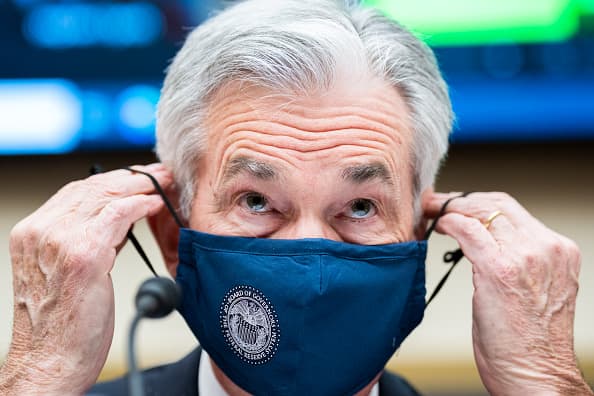Products You May Like
If you want to see how tough it is to be Federal Reserve Chair Jerome Powell, look at the contrasting comments from Cleveland Fed President Loretta Mester and former Dallas Fed President Richard Fisher.
When asked on our air today what the central bank should do in response to the Ukraine crisis, Fisher said, “I wouldn’t respond to what’s happening in Ukraine, mainly because we don’t know how long it will last.”
At the same time, Mester was speaking at a conference at her organization, where she said the Ukraine crisis “has implications for the economic outlook, adding upside risk to inflation even as it puts downside risks to the growth forecast.”
Those contrasting comments highlight Powell’s dilemma.
The two mandates: Which one gets precedence?
The Fed has two mandates: It’s supposed to help grow the economy, and it’s supposed to fight inflation.
Matt Maley from Miller Tabak notes that “the Ukraine crisis has the potential to slow growth, so arguably the Fed should go slow in raising rates. But the crisis is also stoking inflation, so the Fed can’t ignore that either.”
Which one gets precedence? How does Powell thread that needle?
Maley believes that Powell will adopt the “middle path:” acknowledge growth worries but stay the course on raising rates.
“We have a situation where Powell and the Fed have been wrong on inflation being transitory, so they have to raise rates, otherwise they will lose credibility.”
However, ”the market now believes the Fed is not going to be as aggressive as they were even a month ago.” Maley believes a 50-basis-point hike in March is unlikely. He says the central bank will do 25 basis points in March, but they will leave at least four more hikes on the table for the year.
Maley is particularly worried about the signals from the bond market and what it suggests for potentially lower growth.
“Yields are much lower than they were last Thursday when the war started, but the stock market is not lower. Somebody is wrong, either the bond market or stock market. The bond market is pricing in that this gets worse and that this will affect growth.”
The problem for stocks: Lower growth means lower earnings
Stocks move on some combination of three factors: dividend growth, earnings growth and a market multiple (price-earnings ratio) that is a reflection of how much investors are willing to spend for a future stream of earnings.
Almost all of the decline in stocks this year has been due to multiple compression: The S&P 500 is down nearly 10%, while the market multiple has also declined roughly 10%, from about 21.1 to about 19.1.
At the same time, dividend distributions have risen slightly, while earnings expectations have remained about the same.
Analysts are expecting earnings growth of 7.8% for the S&P 500 in 2022, only slightly below the 8.4% expectations at the start of the year, according to Refinitiv.
Others are expressing the same concern as Maley: that the Ukraine crisis and its subsequent inflation will usher in a second down leg for stocks.
Nick Raich from The Earnings Scout notes that this second down leg may not be due to a decline in the market multiple, but to a real decline in earnings estimates because the Fed’s rate hikes are going to slow the economy.
“We do not know how much the Fed will need to raise interest rates to curb inflation,” Raich told clients. “While some firms are forecasting eight interest rate hikes this year, our research indicates four hikes will stop inflation. That’s the good news. The bad news is that will likely come at the expense of future growth.”
“Over the next few months, a growth scare is likely to arise,” he said.
“You may even start to hear the ‘R word’ [recession], which stocks are not discounting.” Raich noted that if estimates in the second half hold steady in the coming months, “we could become less bearish or even bullish.”
In addition, we also do not know how long the war in Ukraine will last and what economic sanctions will have on the economy.
“The issue is, how does the Fed engineer a soft landing?” Maley asked me. “It’s not clear they can.”
